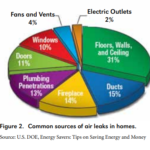I bet you didn’t know your home has a wood toilet. Uh-huh…Yes, it does!
Your wood toilet may not look like the stylish throne pictured above, but the wood toilet you have is actually worse! There is a pejorative name for fireplaces in the energy conservation world. They are called a “wood toilet”. The reason is, you are flushing wood up your chimney, and also watching your energy dollars swirl out with it.
What are you talking about? I love my fireplace!
It is true that according to the NAHB survey as of 2018, 44% of single family houses have at least one open fireplace in them. That is down from a peak of 58% in 2002. Unlike a literal wood toilet, a fireplace is generally a desirable amenity. Some homeowners don’t use their fireplace, and don’t care to use their fireplace. However, some homeowners burn in them every chance they get. I must admit, there is something about a crackling hearth…but is it worth it?
The hard truth about fireplaces, and why are energy conservation people name-calling?
Let me give you some facts about fireplace, reported by the EPA in their Burn Wise campaign.
- There are roughly 17.5 million fireplaces in the US.
- They account for 4,000 residential fires every year.
- Confined fires (like fireplaces) account for 87% of residential building heating fires.
- Smoke from fireplaces contain a mixture of harmful gases and small particles that can cause severe bronchitis, aggravate heart and lung disease, and may increase the likelihood of respiratory illnesses.
- Research estimates 70 percent of smoke from chimneys can actually reenter your home, and your neighbor’s home. (Pierson et al 1989)
Below are the hard facts about what fireplace use does to energy consumption in your home

Fireplaces waste more than they give back. This is what the US Department of Energy has to say about fireplaces.
- Fireplaces should not be considered heating devices.
- Traditional fireplaces draw in as much as 300 cubic feet per minute of heated room air for combustion, then send it straight up the chimney.
- Even when dormant, fireplaces account for 14% of home air leakage.
- Energy.gov Energy Saver program recommends to seal your flue when not in use, and use an inflatable Chimney Balloon or wool Flueblocker.
Are wood toilets super trendy and stylish, and coming back in vogue
150 years ago, home owners all over the globe used fireplaces to heat their homes. They used wood toilets (that were called outhouses) to do their business. They used horses to ride to work or to town. But now we have central heat, and indoor plumbing, and commuter cars and public transit. For nostalgia or old-time-sake feel free to go on a horsey ride, or poop in a smelly old shack, or even warm yourself by the hearth. But don’t fool yourself with your fireplace. This is not little House on the Prairie anymore, so lets be a little smarter with our homes, health, and energy dollar.
